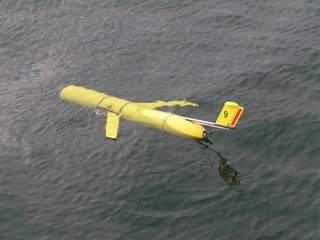Underwater Robots Eavesdrop on Whales
Scientists at the Woods Hole Oceanographic Institution (WHOI) have reported the first use of passive acoustic recorders in an ocean glider, a type of AUV that looks like a large model airplane and can work in water depths to 1,000 meters (about 3,300 feet) or more.
Gliders move both horizontally and vertically in the ocean and work around the clock in all weather conditions, typically up to a month or longer depending on the project.
The vehicle carries a variety of high-resolution sensors to collect oceanogr aphic measurements such as temperature, salinity, and fluorescence (a measure of phytoplankton abundance).
aphic measurements such as temperature, salinity, and fluorescence (a measure of phytoplankton abundance).
Gliders also operate silently, which make them ideal for passive acoustics studies. Researchers say the gliders are a promising, cost-effective, and efficient alternative to long-term ship-based studies given ship costs in the thousands of dollars a day.
Mark Baumgartner, an assistant scientist in the WHOI Biology Department, reported findings from a pilot study involving the deployment of recorder-equipped gliders.
They are finding that the capabilities of this new observing platform allow ecological research that has not been previously possible.
Future work will focus on extending the duration of the recordings, developing a capability to report detections of whale vocalizations to land-based researchers in real time, and monitoring the high-frequency vocalizations of other marine mammals, such as dolphins, sperm whales, and beaked whales.
WHOI : Media Relations : News Release : Monitoring Baleen Whales with Autonomous Underwater Vehicles
Gliders move both horizontally and vertically in the ocean and work around the clock in all weather conditions, typically up to a month or longer depending on the project.
The vehicle carries a variety of high-resolution sensors to collect oceanogr
 aphic measurements such as temperature, salinity, and fluorescence (a measure of phytoplankton abundance).
aphic measurements such as temperature, salinity, and fluorescence (a measure of phytoplankton abundance).Gliders also operate silently, which make them ideal for passive acoustics studies. Researchers say the gliders are a promising, cost-effective, and efficient alternative to long-term ship-based studies given ship costs in the thousands of dollars a day.
Mark Baumgartner, an assistant scientist in the WHOI Biology Department, reported findings from a pilot study involving the deployment of recorder-equipped gliders.
They are finding that the capabilities of this new observing platform allow ecological research that has not been previously possible.
Future work will focus on extending the duration of the recordings, developing a capability to report detections of whale vocalizations to land-based researchers in real time, and monitoring the high-frequency vocalizations of other marine mammals, such as dolphins, sperm whales, and beaked whales.
WHOI : Media Relations : News Release : Monitoring Baleen Whales with Autonomous Underwater Vehicles
Labels: underwater robot

0 Comments:
Post a Comment
Subscribe to Post Comments [Atom]
<< Home